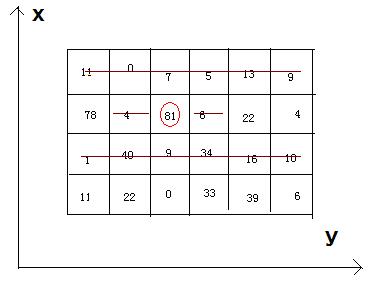HDU2845-Beans
2016-05-19 18:26
302 查看
Beans
Time Limit: 2000/1000 MS (Java/Others) Memory Limit:32768/32768 K (Java/Others)
Total Submission(s): 4174 Accepted Submission(s): 1982
Problem Description
Bean-eating is an interesting game, everyone owns an M*N matrix, which is filled with different qualities beans. Meantime, there is only one bean in any 1*1 grid. Now you want to eat the beans and collect the qualities, but everyone must obey by the following
rules: if you eat the bean at the coordinate(x, y), you can’t eat the beans anyway at the coordinates listed (if exiting): (x, y-1), (x, y+1), and the both rows whose abscissas are x-1 and x+1.

Now, how much qualities can you eat and then get ?
Input
There are a few cases. In each case, there are two integer M (row number) and N (column number). The next M lines each contain N integers, representing the qualities of the beans. We can make sure that the quality of bean isn't beyond 1000, and 1<=M*N<=200000.
Output
For each case, you just output the MAX qualities you can eat and then get.
Sample Input
4 6
11 0 7 5 13 9
78 4 81 6 22 4
1 40 9 34 16 10
11 22 0 33 39 6
Sample Output
242
#include <iostream>
#include <cstdio>
using namespace std;
int main()
{
int x[200009],y[200009],m,n,a;
while(~scanf("%d %d",&m,&n))
{
for(int i=2;i<=m+1;i++)
{
for(int j=2;j<=n+1;j++)
{
scanf("%d",&a);
x[j]=max(x[j-1],x[j-2]+a);
}
y[i]=max(y[i-1],y[i-2]+x[n+1]);
}
printf("%d\n",y[m+1]);
}
return 0;
}
相关文章推荐
- <JS>显示和基本操作
- 新浪微博用户兴趣建模系统架构
- iOS 刘璐懒加载 进入应用程序时卡住很长时间。
- The mind
- 基础级 - sweetAlert
- 嵌入式技术学习路线分享
- 写脚本遇到的问题(一)
- [架构设计]第三讲:软件架构的目的
- 基于AOA协议实现Android设备的USB通信
- mysql where执行顺序
- Longest Increasing Subsequence
- 解决vs2015使用fopen、fprintf等函数报错的问题
- C中数组与指针【转】
- android中xmlns:tools属性详解
- IE浏览器中div和li包裹的img有5px空白的解决方案
- Hadoop 在Windows7操作系统下使用Eclipse来搭建hadoop开发环境
- 一个iframe怎样浮动在另一个大的iframe上面
- 博客搬家啦~Winter3un.github.io
- Linux shell 时间相关处理
- Maven打Jar包方法
